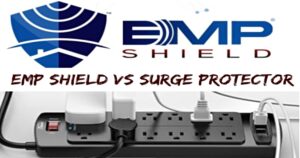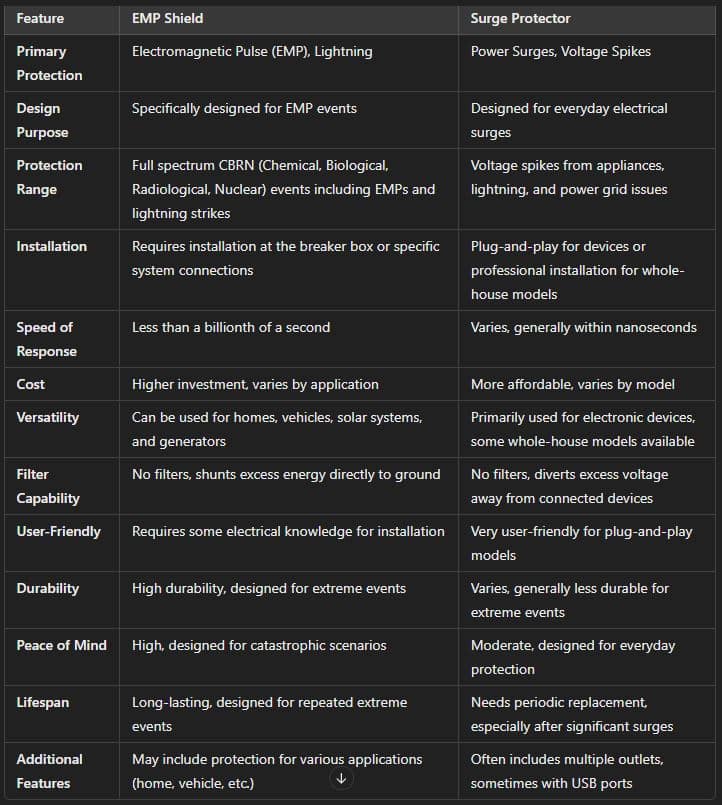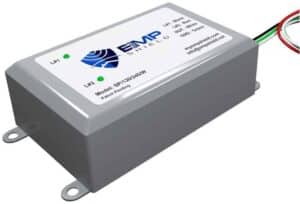 Today, we’re diving into the nitty-gritty of two essential devices that can protect your electronics from the bad guys of the electrical world:EMP Shield vs the humble Surge Protector.
Today, we’re diving into the nitty-gritty of two essential devices that can protect your electronics from the bad guys of the electrical world:EMP Shield vs the humble Surge Protector.
You might be thinking, “Aren’t these basically the same thing?”
Well, strap in, because you’re about to find out just how wrong you are.
EMP Shield Vs Surge Protector Comparision Chart

EMP Shield vs Surge Protector: What Are We Up Against?
First things first, let’s talk about what these bad boys are designed to protect you from.
We’re talking about two different kinds of electrical nasties:
Electromagnetic Pulses (EMP) and power surges.
EMPs: The Invisible Villain
An EMP, or Electromagnetic Pulse, is like a ninja strike on your electronics.
It can come from a nuclear detonation high up in the atmosphere or from a geomagnetic storm courtesy of our temperamental friend, the sun.
When an EMP hits, it’s all over for unprotected electronics – we’re talking fried circuits and total annihilation.
And let’s face it, in a world where our lives are practically glued to electronic devices, an EMP could be a real doomsday scenario.
↓ This is What an EMP Attack Looks Like in America
Power Surges: The Everyday Menace
On the other hand, power surges are the more common, everyday gremlins.
They can happen anytime your electrical system gets a sudden spike in voltage.
Think short-term outages, power grid fluctuations, or even the refrigerator kicking on.
These surges can sneak in and slowly degrade your electronics over time or, worse, zap them out in one go.
EMP Shield: The Knight in Shining Armor
 So, what’s an EMP Shield, and how does it defend against the end-of-the-world scenario?
So, what’s an EMP Shield, and how does it defend against the end-of-the-world scenario?
The EMP Shield is a device designed specifically to protect your electronics from the massive burst of energy that comes with an EMP.
It’s like a magical barrier that absorbs the energy and grounds it safely, keeping your devices out of harm’s way.
↓ EMP Protection of Critical Infrastructure – Ted Nugent
How It Works
The EMP Shield detects the EMP’s rapid rise time and instantly shunts the excess energy to the ground before it can reach your sensitive electronics.
It’s designed to react in less than a billionth of a second.
That’s faster than your morning coffee kicks in!
This speed is crucial because an EMP’s impact can be over in milliseconds, but the damage is done almost instantaneously.
Installation and Coverage
Installation is pretty straightforward.
You can get EMP Shields for various applications – from your home and vehicle to solar panels and generators.
For home use, it typically involves connecting the device to your home’s electrical system at the breaker box.
It’s a bit of DIY, but nothing a handy prepper like you can’t handle.
Pros and Cons
Pros:
- Ultimate Protection: Nothing beats it when it comes to defending against EMPs.
- Multi-Purpose: Can protect a range of devices and systems.
- Peace of Mind: Sleep easy, knowing you’re ready for the worst.
Cons:
- Cost: It’s a bit of an investment, but can you really put a price on peace of mind?
- Installation: Some might find the installation a bit daunting, but it’s manageable with a little effort.
Surge Protector: The Everyday Hero
 Now, let’s turn our attention to the trusty Surge Protector.
Now, let’s turn our attention to the trusty Surge Protector.
These guys are the unsung heroes of everyday electronic protection.
They’re everywhere – under desks, behind entertainment centers, and pretty much anywhere you’ve got a cluster of plugs.
How It Works
Surge protectors are designed to detect excess voltage and divert it away from your devices, usually into a grounding wire.
They’re like the traffic cops of your electrical system, redirecting dangerous surges away from your expensive electronics.
Some are as simple as power strips, while others can be installed directly into your home’s electrical panel for whole-house protection.
Installation and Coverage
For the plug-and-play models, installation is as simple as plugging it into the wall and connecting your devices.
For whole-house surge protectors, it’s a bit more involved and might require a pro electrician.
But once it’s set up, it provides a blanket of protection over all your home’s electronics.
Pros and Cons
Pros:
- Affordable: Easy on the wallet.
- Simple to Use: Plug it in, and you’re good to go.
- Widely Available: You can pick one up at any hardware or electronics store.
Cons:
- Limited Protection: Great for everyday surges, but won’t save you from an EMP.
- Lifespan: They wear out over time and need to be replaced periodically.
- False Security: Some cheaper models might not offer as much protection as you think.
EMP Shield vs. Surge Protector: The Showdown
Alright, so we’ve got our contenders.
Now, let’s see how they stack up in a head-to-head comparison.
Protection Level
The EMP Shield is the heavyweight champion when it comes to protecting against EMPs.
It’s specifically designed for this purpose, whereas a surge protector wouldn’t stand a chance against an EMP’s raw power.
Surge protectors, on the other hand, are excellent for everyday protection against power surges.
They’re the perfect solution for the small, frequent voltage spikes that can slowly damage your electronics over time.
Versatility
EMP Shield can be used in a variety of applications – homes, vehicles, solar systems, you name it.
They’re versatile and provide a broad spectrum of protection against EMPs and lightning strikes.
Surge protectors are more specialized, mainly focused on protecting individual devices or entire home systems from power surges.
They’re versatile in their own right but within the scope of power surges.
Cost
There’s no sugar-coating it: EMP Shields are an investment.
They’re pricier than your average surge protector, but they offer a level of protection that’s unparalleled.
Surge protectors are much more affordable, making them an easy addition to any home.
You can get decent models for relatively cheap, though higher-end, whole-house surge protectors will cost more.
Ease of Use
Surge protectors win hands down in the ease-of-use category.
They’re straightforward – just plug and play.
EMP Shields require a bit more effort, especially for those uncomfortable with electrical work, but they’re still within the realm of DIY if you’re handy.
Do You Need Both?
Here’s the kicker: in an ideal world, you’d have both.
Surge protectors are great for everyday use, keeping your electronics safe from the regular power surges that are part of life.
But if you’re serious about preparedness and want to be ready for the big one – an EMP – then an EMP Shield is the way to go.
Having both ensures you’re covered on all fronts.
It’s like having a first-aid kit and a trauma kit – you hope you’ll never need the big guns, but you’ll sleep better knowing you’re prepared for anything.
EMP Shield vs Surge Protector: Final Thoughts
So, there you have it, folks.
The EMP Shield and the Surge Protector both have their places in a well-rounded preparedness plan.
The Surge Protector is your everyday defender, quietly guarding your electronics from the little spikes that can cause big problems over time.
The EMP Shield, however, is your knight in shining armor, ready to step in when the really bad stuff hits the fan.
Investing in both gives you a comprehensive shield against the electrical nasties out there, whether they come from a thunderstorm or a high-altitude detonation.
Remember, being prepared isn’t just about stockpiling supplies – it’s about protecting the tools and technology that help you survive and thrive in an uncertain world.
Why Trust Skilled Survival…
Go here now to review a full breakdown of:
- Who We Are
- Our Credentials
- Our Mission
- & Product Recommendations…
Here are a few highlights of our teams credentials & certifications:
- Certified Member of a Mountain Search & Rescue Organization
- Plant Emergency & Safety Leader for a Major Food Manufacturer
- Member of the 10TH Mountain Division Hut Association
- Certifications: Avalanche 1, WFR, CPR
- Official Gear Tester for Numerous Outdoor Gear Companies
- Countless Multiday Backpacking trips into Remote Wilderness
- Bachelor’s Degree In Mechanical Engineering
- Bachelor’s Degree In Civil Engineering
- Bachelor’s Degree In Biomedical Engineering
“It takes 20 years to build a reputation and five minutes to ruin it.” – Warren Buffett
We’re fully aware that trust is NOT something you GET but is EARNED.
And we’ll continue to earn YOUR trust through our forthright and honest approach with each new Blog Post, Guide & Product we create…
Prepare, Adapt & Overcome,



Get My 10 Steps To Basic Preparedness Video For FREE.
Plus daily survival tips (unsubscribe anytime).
Read the full article here

